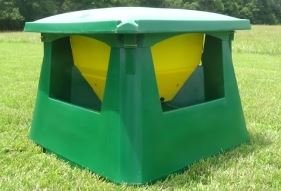Supplying the right minerals to livestock is one of the most important responsibilities of any farmer. A balanced diet ensures healthy growth, reproduction, and disease prevention. This is where cattle mineral feeders play a vital role. These feeders allow animals to access essential minerals whenever they need them. At the same time, farmers who also manage sheep often rely on sheep waterers to provide clean water for their flocks. In this guide, we will explore everything you need to know about cattle mineral feeders, their benefits, types, and tips for effective use.
Why Mineral Supplementation Matters for Cattle
Cattle require minerals for numerous functions such as bone development, milk production, and overall immunity. A deficiency in key minerals like calcium, phosphorus, or salt can lead to health problems and lower productivity. While you could provide minerals manually, this approach is time-consuming and inconsistent. Cattle mineral feeders solve this problem by giving livestock continuous access to the nutrients they need. This approach improves feed efficiency, enhances weight gain, and supports reproductive performance. Similarly, providing sheep with clean water through sheep waterers ensures they remain healthy and hydrated.
How Cattle Mineral Feeders Work
Cattle mineral feeders are designed to protect minerals from weather elements like rain, snow, and wind while allowing cattle easy access. Most models include a covered compartment or a rotating lid that shields minerals from moisture. This is important because wet minerals harden and become unpalatable for cattle. Some feeders are portable, making it easy to move them across pastures as needed. By placing these feeders in convenient locations, you can ensure that minerals remain clean, fresh, and available at all times.
Different Types of Cattle Mineral Feeders
There are several designs to choose from when selecting cattle mineral feeders. Ground feeders are simple and low to the ground, ideal for pastures where cattle graze freely. Tub-style feeders are another common choice, often featuring rotating lids that protect minerals from rain. Portable feeders are great for rotational grazing systems because they can be moved easily. Heavy-duty feeders are recommended for larger herds to handle frequent use. When managing multiple livestock species, pairing mineral feeders with sheep waterers can help maintain both mineral intake and hydration needs effectively.
Benefits of Using Cattle Mineral Feeders
One of the main benefits of cattle mineral feeders is convenience. They allow you to provide minerals without constant supervision, which saves time and labor. These feeders also prevent wastage, as minerals are protected from wind and rain. Healthy mineral intake supports weight gain, milk production, and reproductive health, which ultimately improves farm profitability. When used alongside proper hydration systems like sheep waterers, they help create a well-balanced environment for all your livestock. Healthy animals mean less veterinary expense and better overall performance.
Choosing the Right Cattle Mineral Feeders for Your Farm
When selecting cattle mineral feeders, consider factors like herd size, climate, and location. For large herds, heavy-duty feeders with larger capacity are a good investment. If you live in an area with heavy rainfall or snow, opt for feeders with superior weather protection features. Easy maintenance is another key factor, as feeders need regular cleaning to prevent mold or contamination. Farmers who also raise sheep should think about feeder placement near water sources, such as where sheep waterers are installed, to encourage both mineral intake and proper hydration.
Installation Tips for Maximum Efficiency
Placement matters when it comes to installing cattle mineral feeders. Position them in high-traffic areas where cattle naturally gather, such as near water sources or shade. Avoid muddy or low-lying areas that may flood during heavy rains, as this can damage the minerals. If your farm uses rotational grazing, choose portable feeders for flexibility. Combining the right installation strategy with nearby sheep waterers can create a balanced and efficient setup for your entire livestock operation.
Maintenance Tips for Long-Term Use
Regular maintenance is essential to keep cattle mineral feeders in good condition. Clean them periodically to remove old or contaminated minerals, as stale minerals discourage cattle from consuming them. Check for cracks, broken lids, or sharp edges that could harm animals. Keeping the feeders in top shape ensures that your investment lasts for years. Likewise, maintain your sheep waterers regularly, as clean water supports mineral absorption and overall health for your animals.
Common Challenges and How to Overcome Them
One challenge farmers face is mineral wastage due to weather exposure. Choosing feeders with protective covers or rotating lids can help. Another issue is overconsumption by dominant animals, which can be controlled by placing multiple feeders in different areas of the pasture. For mixed-species farms, ensuring that sheep waterers and mineral feeders are placed strategically helps prevent overcrowding and promotes equal access for all animals.
The Future of Livestock Feeding Solutions
Technology is making livestock care easier and more efficient. Modern cattle mineral feeders now include weatherproof designs, better materials for durability, and even features that minimize waste. Some advanced models are designed for easy portability and can be integrated into rotational grazing systems. Similarly, sheep waterers are evolving with automated systems that maintain clean water without constant human intervention. These innovations make it easier for farmers to manage nutrition and hydration while reducing labor and costs.
Conclusion
Cattle mineral feeders are more than just feeding tools—they are an essential part of maintaining herd health and productivity. By providing easy and consistent access to minerals, these feeders support growth, reproduction, and overall well-being. When combined with clean water from sheep waterers, they create a balanced system that keeps livestock healthy and thriving. From choosing the right type of feeder to proper installation and maintenance, every step counts. Investing in high-quality feeders today can lead to healthier animals and better returns for your farm tomorrow.
